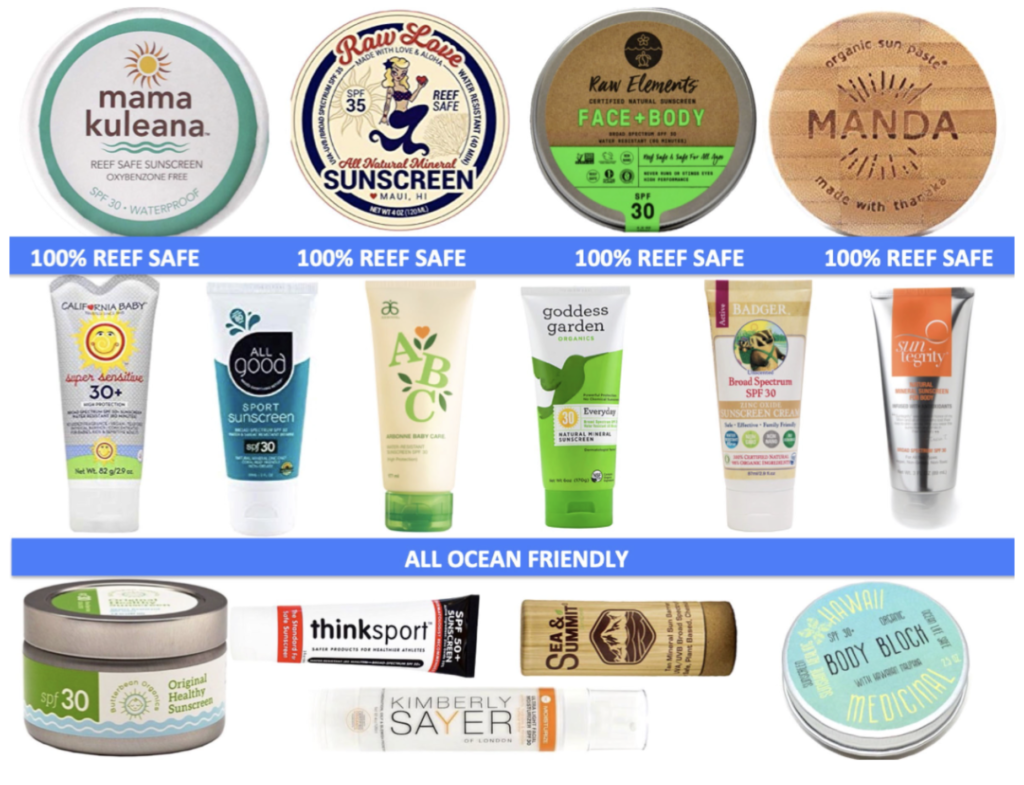
Have you seen reef-safe or reef-friendly labels on recent sunscreen labels? Want to know what the difference is between them, and if reef-safe sunscreen actually matters? This is the post for you.
What is Reef-Safe Sunscreen?
With most things in our human relationship with the natural world, ignorance on our end leads to damage on its end. While we’ve been protecting our skin from the potential harm of the sun’s rays, we’ve simultaneously been pumping chemicals into our ocean’s ecosystems and feeding our skin equal consequences. Reef-safe sunscreen is the solution.
I’m a big sunscreen advocate. Skin cancer runs in my family, and coupled with my irrational fear of the natural aging process, I’ve been slathering on SPF since I was a kid. We don’t learn much about what sunscreen is, how it works, or how it affects our environment when we’re taught to never go without it.
There is a way for us to use sunscreen without harming the natural world or our own health, and the answer is simply changing the sunscreen we use. To make a long story short, what’s toxic for our oceans is also toxic for our health. The answer is to move away from chemical sunscreens and towards reef-safe sunscreens.
Reef-Safe? Physical? Mineral?
Mineral sunscreens have many names, like physical and reef-safe sunscreens. At their core, they all share the same bones and values. Mineral sunscreen doesn’t require chemicals to activate its sun-protecting ingredients. The ingredients in mineral sunscreen are safe for our skin and oceans, so why not make it mainstream? The toxic ingredients in chemical sunscreen can lead to cancer and other health issues, but we shouldn’t have to avoid sunscreen altogether to avoid these consequences and risk the health issues that come with overexposure to the sun. As a surfer and surf instructor, I want to be able to protect my skin while also being able to spend full days in the sun and not damage our reefs and marine life in the process.
Whether your go-to body of water activity is at the pool, lake, ocean, or frat party water slide this summer… reef-safe sunscreen should be the only sunscreen you wear, and you’re about to find out why.
A Reef-Safe Sunscreen Guide:
- Why your sunscreen choice matters
- Sunscreen and our ecosystem
- Sunscreen Accessibility
- What to avoid in sunscreens
- What you already own
- How to find reef-safe sunscreens
Why Your Sunscreen Choice Matters
With summer in full swing in the northern hemisphere, and right around the corner in the southern, sunscreen is starting to find its way back into shopping carts. The UV is increasing, and so should the sunblock application. Sunscreen is so important for our health and should not be skimped out of laziness or lack of access. Studies even show that blue light from our screens can cause skin damage, and mineral-sunscreen can protect us from it. A lot of popular sunscreens are chemical-based, which mean they contain chemicals that harm our oceans and its marine life and reefs. It is our responsibility to wear sunscreen that both protects our skin and the biodiversity of our seas.
Other sunscreens are undoubtedly still on the market because there is an endless list of activities that take place in the sun requiring sun protection that doesn’t interact with the natural environment (tanning, pool parties, spending time outside during peak UV, gardening, etc) where using chemical sunscreen would pose no harm to the natural environment. The kicker with chemical sunscreen is that even if you’re using it for one of these activities you are still exposing your skin to the harmful chemicals found in most of these products.
But at the end of the day, using chemical sunscreen minimally for sterile activities is fine since it increases sunscreen accessibility. If all you have access to is a chemical sunscreen, it is at least protecting your skin from the possibility of skin cancer, and I would still recommend using it rather than not. If traditional sunscreen brands and formulas are the only accessible options for you, then continue to use them.
Sunscreen and Our Ecosystem
Reef-safe sunscreen is mineral-based rather than chemical-based; mineral sunscreens are also known as physical sunscreens. While chemical sunscreens need time to absorb in order to activate after applying, physical sunscreens immediately begin reflecting UV rays from the moment you apply them. Chemicals found in conventional sunscreens can cause great harm to different organisms, ecosystems, and reefs in our oceans. The ocean is harmed in more ways than one by chemicals pumped into its environment, just like the different effects chemicals can have on our health. This image from NOAA does a good job of illustrating some of the different impacts.
The chemicals found in conventional sunscreens aren’t just harmful to biodiversity; these same chemicals are harsh on our skin and harmful to our health. In the world of sustainability, less is always more, and the sunscreen we use doesn’t need a grocery list of chemicals to be effective in sun protection.
Sunscreen Accessibility
The biggest problems slowing the advancement of reef-safe sunscreen are a lack of education about it, coupled with higher prices and a lack of access to options. There should be regulations on the chemicals allowed in mass-manufactured sunscreens, but there aren’t. Until there are, it’s really up to us to put in a few extra moments of thought into what we’re purchasing and using.
While I still use traditional sunscreen brands for certain activities when they are the only ones accessible, I prioritize reef-safe sunscreen whenever possible. As I continue on my detoxifying journey in all areas of my life, certain sunscreens are being completely phased out of my drawers. I believe in the power of informed consumer choices and their impact on the market. My goal here is to empower you to make the consumer purchase that works for you because, again, this responsibility has unfairly fallen on us as consumers rather than the companies. If you have the capacity to buy mineral sunscreen it is very important to do so- increasing demand will eventually increase accessibility.
Which Ingredients to Avoid in Sunscreens
The easiest sunscreen to remember to avoid is spray sunscreen. Almost all spray sunscreens contain the harmful chemicals we’re trying to avoid to protect the ocean and our health. Until the story changes for spray sunscreen products and companies remove these ingredients, we must opt out. The golden rule is slather, don’t spray.
For liquid and lotion sunscreens, there are certain chemical ingredients that are harmful to our health and our oceans. When you’re reading the back of a bottle you’ll see some of these ingredients on almost every product. That is because these are the ingredients that create the actual sun protection so they are essentially what make the product valid.
Chemical ingredients to avoid, in order of terribleness:
- Oxybenzone
- Octinoxate
- Benzophenone
- Homosalate
- Octisalate
- Avobenzone
- Methylbenzylidene camphor
- Petrolatum
- And more
Physical sunscreens have fewer ingredients and tend to be easier to read. The main ingredients are zinc oxide and titanium dioxide, neither of which penetrates the skin or causes coral bleaching. There is some research that looks at high amounts of titanium dioxide mixing with warm water to produce a reaction that causes coral bleaching, but that science complicates the transition from chemical to physical sunscreen and I wouldn’t worry about it as a consumer.
What Sunscreens You Already Own
Chances are, you already have some variations of sunscreen in your drawer, and making use of what we already own is the top way to be sustainable.
The first step for your skin is to check the expiration date because sunscreen DOES expire. Applying expired sunscreen will not protect your skin from harmful rays.
From here, you can decide what you want to do with your usable sunscreens going forward. I recommend using your chemical sunscreens until they are finished, but not using them if you are going in or near the ocean. Once you have some empty or banished bottles, proceed to the following two options.
Repurpose!
You can use old sunscreen lotion bottles to store valuables at the beach or pool. Just clean out the bottle and hide away any cash or jewelry from sight from thieves. You can also bring old sunscreen lotion bottles to bulk stores and fill them up with more sunscreen! If you’re tossing your bottles, read below.
Recycle.
If the sunscreen bottle is recyclable, you can follow a few simple steps to recycle it properly. Remove the cap and toss it in the trash. Empty out any remaining product. Rinse out the container and let it dry. Once your container is clean and dry, it is set to be recycled!
The Best Reef-Safe Sunscreens Brands and How to Find Them
While the easiest way to find a reliable sunscreen in a sea of options is to look for a specific brand, rather than searching through ingredients, some stores have limited stocked options. Having go-to brands and an ability to read ingredients will set you up to find mineral sunscreen wherever you shop.
Greenwashing on labels can often lead consumers to make a purchase that they believe to be in favor of the environment but is actually no better than products they were trying to avoid that they knew to be bad for the environment. Don’t let evil corporate advertising stray you from voting with your dollar! Look out for misleading labels like “reef-friendly,” which does not mean safe and could contain harmful ingredients. Chemical sunscreens with “environmentally friendly” covers can also be placed next to mineral sunscreens to try and win a purchase by the association. Always check the ingredients before you assume a sunscreen is safe.
The ingredient to look for in reef-safe sunscreen is zinc oxide, which doesn’t require or create a reaction to active ingredients. Some other ingredients that are added to zinc sunscreens can counteract zinc oxide and make the sunscreen harmful.
There are brands that only make completely reef-safe products and there are others that have both harmful and safe products. This is something to note when making purchasing decisions. Just because you see an obviously labeled mineral sunscreen product from a brand doesn’t mean that their other products are reef-safe.
Reef-Safe Sunscreen Brands

This image from savethereef.org presents some mineral sunscreen options. The list below are all reef-safe options, to name a few, that you can order online or look for in your local store. This list is just to get you started because there are so many options out there!
I’m excited for you to embark on this new reef-safe journey. Your skin, health, and our oceans are going to thank you.
If you have any other tips for readers who are starting a mineral sunscreen journey, drop them in the comments!
References
“10 Sunscreen Mistakes You Do Not Realize You Are Making and How to Choose a Sunscreen: Dermatology of Boca: Dermatologists.” Accessed June 22, 2024. https://www.dermatologyofboca.com/blog/10-sunscreen-mistakes-you-do-not-realize-you-are-making-and-how-to-choose-a-sunscreen.
admin. “Sunscreen 101: Protect Your Skin and Coral Reefs.” Coral Reef Alliance, September 28, 2021. https://coral.org/en/blog/sunscreen-101-protecting-your-skin-and-coral-reefs/.
Okoh, Caroline Nkoye. “How Sunscreen Protects Against Blue Light.” Black Girl Sunscreen, May 25, 2022. https://www.blackgirlsunscreen.com/blue-light-sunscreen/.
People4Ocean. “5 Reasons to Use Reef Friendly Sunscreen,” July 12, 2020. https://www.people4ocean.com/blogs/blog/5-reasons-to-use-reef-safe-sunscreen.
“Your Guide to Reef Friendly Sunscreens.” Accessed May 12, 2024. https://www.surfrider.org/news/your-guide-to-reef-friendly-sunscreens.



